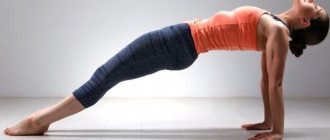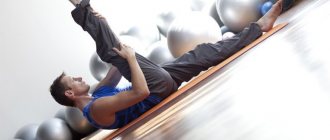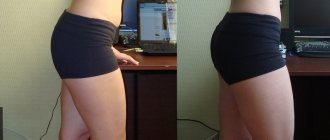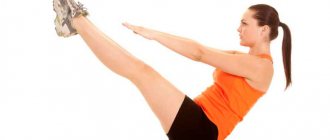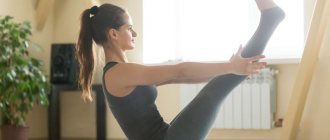How quickly will your stomach tighten?
The answer to the question whether a vacuum helps get rid of a tummy is clear: it will help 100% if you don’t feel sorry for yourself and master the correct technique.
Practice and reviews on forums show that on average, one month of daily exercise is enough for the results to be clearly noticeable. Read the reviews and you will no longer doubt whether vacuum gymnastics helps. Try to personally hold out for just one month, and then you won’t leave her. Because you are guaranteed to notice a decrease in waist size and an increase in the overall tone of the abdominal muscles.
It's very easy to get started: you don't even need sportswear, just work out in what you're wearing. Stand up or lie down to try easier variations of the movements and do at least 5 repetitions.
Start your journey to a beautiful figure right now!
(2 ratings, average 3.5 out of 5)
Contraindications
Like any exercise, vacuum has its contraindications:
- Performing the exercise is strictly prohibited for pregnant girls.
- It is necessary to refuse to perform the exercise during critical days.
- Also for people with infectious diseases, abdominal diseases, intestinal diseases, heart disease, people with intraperitoneal pressure, the presence of uterine fibroids, and so on. There are a lot of contraindications and a complete list of diseases can be found on the Internet.
Also, if there are no contraindications, do not neglect safety precautions when performing this exercise. If you do not follow certain rules when performing exercises, they can cause great harm.
If there are contraindications, then you should not be negligent about your health. It is worth choosing an exercise that will suit you. For an accurate result, it is better to consult a specialist. He will give the necessary recommendations and select the safest exercises, taking into account all the characteristics of health and the body.
Thus, having studied this exercise, we can conclude that it is not intended to reduce the waist, but to gently massage the internal organs, get rid of vesicular fat, normalize blood circulation, as well as to tone and strengthen the abdominal muscles. Exercise won't help reduce your waistline, and the results women see are likely due to increased activity levels or dietary changes.
Solid vacuum
Refilling the TV with plasma
| He is standing on something invisible. He walks through the vacuum as if on dry land. And we also follow him along something invisible. It is something more transparent than glass and even air. Cold unblinking stars above our heads and cold unblinking stars under our soles, distinct, like pebbles at the bottom of a mountain lake. It's even scary. The legs are standing on something unknown. “Almighty, how did this come into your head?” - Well, yesterday I was lying and thinking: what should I show the guest? Here they seem to be shouting: “Can’t you turn the liquid phase into a solid?” And we talked so much, talked so much about the consistency of a vacuum. Well, I made up the equation... He squatted down and began to quickly write something on the firmament. His pencil left luminous marks. Colored lines hung above the black-star glass. |
| Georgy Gurevich |
Internal abdominal muscles
The abdominal muscle area consists of external and internal muscles. The external muscles are the rectus abdominis and the external obliques. Crunches force the rectus muscle to move. Forward crunches engage the entire rectus abdominis muscle. When this movement enters the active phase, your hip flexors come into play. And the obliques are more strongly affected by the serious rotation when you reach the opposite knee with your elbow.
The major rectus transversus and psoas muscles are part of the internal abdominal muscles. These muscles are rarely talked about and rarely exercised. These muscles lie under the rectus abdominis and oblique abdominal muscles. Intrinsic muscles help maintain body position and control the depth of breathing during heavy strength exercises such as weighted squats.
The essence
So, in order to get to the bottom of the matter and the benefits (let’s just say, scanty) that a vacuum can give us, it’s worth dispelling a couple of myths that distort the very essence of the vacuum exercise. These mistakes are fundamental and are found in a huge number of fitness experts, public pages and websites. Remember, if you see such statements, immediately close VK/Insta/Google - this means that the person is absolutely “off topic” and will now advise you all sorts of nonsense.
In order to understand the structure of the press, study the article “Press”: myth or reality?.
Myth one: the stomach sticks out due to a weak transverse muscle
The stereotype of abdominal prolapse due to a weak transverse section is paradoxical given the current level of anatomy and physiology. Any physical therapist or truly knowledgeable fitness trainer will see a breakdown in cause and effect. We don’t understand at all why the transverse muscle was assigned such a function.
The transverse abdominis muscle reduces the volume of the abdominal cavity as if on the sides. Prolapse of the abdomen forward is atrophy and hypotonicity of the rectus abdominis muscles
. The transverse cannot affect such an expansion! Weakness of the transverse abdominis muscle leads to a lateral bulge of the waist rather than a frontal bulge.
That is, if your transverse muscle is in poor condition, then it will “enlarge” your waist (read: make you look like a tree stump or Cara Delevingne), but will not contribute to the prolapse of your stomach forward.
Even logically, this should be clear: the transverse muscle is a thin muscle-tendon plate, the muscle bundles of which are directed transversely. The anterior abdominal muscle is flat and wide in shape. She holds back your belly like the Nevsky Livonian Order.
You can check the tone of your transverse abdominal muscle right now! To do this, just try to draw in your stomach as much as possible while continuing to breathe. If your shoulders are lifted up and you can’t pull in your stomach any other way, then a vacuum is even recommended for you. If you managed to pull in your stomach without amplitude in the shoulder girdle, then read the list of contraindications, since the tone of your abdominal muscles is normal, and the reason for your protruding stomach lies elsewhere.
Second: “vacuum trains muscles”
No no no. With the initial, technically correct implementation of the vacuum, as described above, the abdominal muscles do not contract at all! They stretch, and the stomach rises and “sticks” not due to muscle effort, but due to the difference in pressure between the chest and abdominal cavity and the expansion of the chest by the force of the external intercostal muscles.
Third: exercise helps reduce belly fat after childbirth
Doing a vacuum exercise to remove belly fat
This element came to us from yoga, but is already used in various fitness training, and sometimes as an independent exercise. It takes just a few minutes to complete, and can be easily performed by both beginners in fitness and sports, as well as more experienced lovers of an active lifestyle. Bodyflex training, for example, is a set of exercises performed based on the vacuum exercise for the abdomen.
The meaning of the element comes down to the following: you need to take a deep breath, exhale sharply, while drawing in your stomach as much as possible, and stay in this position for a few seconds (without inhaling). Keep in mind that performing the abdominal vacuum exercise is somewhat more difficult than it seems at first glance.
What does the vacuum exercise do? Many people who want to have a flat tummy actively take up abdominal exercises. But if you just pump up your abs without first getting rid of excess fat, no abs will be visible, and visually your abdominal volume and waist thickness may even increase. “Classical” abdominal exercises - various twists, leg or torso lifts, mainly work the rectus abdominis muscle, the same upper and lower abs. The transverse muscle is responsible for reducing the volume of the abdominal cavity and keeping the abdomen taut. The stronger it is, the thinner the waist will look and the less fat there will be. Moreover, the transverse muscle supports the abdominal organs in an anatomically correct position and serves as a kind of corset in the abdominal area. A strong transverse muscle helps stabilize the lumbar spine and pelvic bones.
How to do a stomach vacuum correctly
As with many static exercises, the result of training depends on conscious control of body movements and correct technique.
The latter includes six stages:
- Sit in a comfortable position.
- Take a calm breath, then exhale slowly, trying to release as much air as possible.
- After this, take a false breath with your chest and at the same time pull your stomach inward. Due to the difference in pressure, the organs themselves will pull themselves towards the diaphragm, although at first you can slightly help yourself with the abdominal muscles.
- Fix the position for a comfortable time (from 15 to 50 seconds).
- Exhale falsely and return to the starting position.
- Take several even breaths and exhalations to relax, and then repeat steps 2 - 6 the desired number of times.
It is more useful for beginners to practice lying down and limit the breath-hold to 5-8 seconds, with a gradual increase in time up to a minute. The minimum number of repetitions is 3, and the maximum is 15.
Have you been working out your abs for a long time, wanting to get a narrow waist, but nothing has changed? I sympathize, because this will not happen if you achieve it in this way. The only option to reduce your waist is to perform a stomach vacuum correctly.
It all started with Yoga
– The abdominal vacuum was borrowed from Yoga practices.
According to their teachings, performing this movement opens the chakras, which allows a person to live easier. One cannot but agree here - after all, living with a beautiful and flat stomach is better than living with a sagging belly.
The vacuum is useful both for ordinary people who want to get in shape for the summer season, and for competitive bodybuilders. For the first, the exercise helps to gain a muscle corset that supports the stomach even after eating, and for the second, it allows you to keep your abs tense longer while posing on stage.
Some people have a wide waist genetically. Trying to correct the situation, they begin to pump up their abs, go on a diet, but only make the situation worse.
They will burn fat, but the waist will remain visually thick. After all, it is logical that by pumping up the abdominal muscles, they increase, thereby thickening the waist. So if someone tells you to do side presses to shrink your belly, hit them. Just kidding, I'm just kidding =).
The secret of a narrow waist
– How to do a stomach vacuum correctly so that the effect is noticeable to the naked eye?
It’s very simple - you need to do it SIS-TE-MA-TI-CHE-SKI! Stick to consistency, and very soon you will amaze your friends with your excellent physical shape. The teaching stage is over, now let's move on to practical information.
– It is best to do this exercise on an empty stomach.
2-2.5 hours after eating or in the morning, immediately after the morning toilet. A full stomach will negatively affect the effectiveness of the exercise; in addition, food may well “ask” to come out.
Before starting the exercise, you need to catch your breath by doing several breathing cycles. After this, release as much air as possible from your lungs and hold your breath. Next, pull your stomach under your chest and hold for a few seconds, then inhale air and relax. Rest a little, then repeat the exercise.
– Why let the air out of your lungs?
Air-filled lungs will prevent the diaphragm from contracting.
– How long do you need to hold?
For starters, 5 seconds is enough, but then, the holding time should gradually be increased to 20-30 seconds.
- Time relax.
After each approach, you can rest for 5-10 seconds. Those who have already achieved some success do not rest between approaches, limiting themselves to a few breaths.
– How many approaches should be done?
At first, 5-6 approaches will be enough. Next, increase their number to 12 - 15.
– How many times a week should you do a vacuum?
For a noticeable effect, two or three workouts are enough, however, some fans practice vacuum once or even twice a day.
Execution options
There are many types of waist narrowing vacuums. By and large, they differ in the form of execution, which determines the complexity of the exercise.
There are the following types of vacuum:
- From a lying position.
- Standing with emphasis on something, for example, on your knees.
- Normal vertical position.
- Standing with your arms raised above your head.
In this list, the lower the exercise is, the harder it is to perform. Therefore, those who have minimal sports experience should start doing it from a lying position.
First, oddly enough, you need to lie on the floor with your legs bent and your arms extended along your body.
Next, the technique is similar to what we discussed above - exhale, pull your stomach under your chest, hold for a few seconds and release. This type of vacuum can be done immediately after waking up, without getting out of bed.
As soon as you can do the vacuum while lying down without rest, for 15 sets of 20 seconds, move on to more difficult options.
For any diseases of the respiratory, digestive, and cardiovascular systems. In addition, vacuum is contraindicated for girls during pregnancy and menstrual periods.
That's all. I hope my article helped you understand how to properly do a stomach vacuum. You can practice it anywhere, the main thing is to remember the consistency and technique of training. If these conditions are met, getting a thin waist is only a matter of time.
How to do the vacuum exercise correctly while lying, standing and sitting
The vacuum itself is performed in the only way - as we wrote above. Only the starting position is different.
Technique for performing a vacuum for the abdomen from a supine position
- Lie on the mat, bend your knees
- Place your arms at your sides or spread them apart
- The back should be straight
- Inhale-exhale-retract the abdomen according to the above scheme
- The advantage of this option is that it is easy for beginners and can be done without getting out of bed.
Doing the exercise while sitting
- Sit on a hard surface or exercise ball
- Place your palms on your knees
- The angle between the thigh and shin should be straight
- Feet are placed on the floor
- If you perform the exercise while sitting on a chair, do not lean on its back
- Do the exercise three times
Technique of performing on all fours
- Get on all fours: your shoulders should be level above your arms, your buttocks should be above your knees, and your neck and head should be parallel to the floor.
- Doing the exercise
Vacuum for a flat stomach from a standing position:
- Option 1: Stand straight with your feet shoulder-width apart.
- Or the second option: legs bent at the knees, buttocks pulled back, and hands resting on knees or thighs
It is believed that it is from a standing position that one can inhale the stomach exactly as needed. If you can’t do the exercise while standing, practice first in other starting positions.
Advantages
It would seem, what does a simple retraction of the abdomen give? Much depends on how to do the vacuum exercise, how much, how often, but in general, you can soon count on the following effects:
- Getting rid of prolapse of the abdomen forward;
- Noticeable narrowing of the waist;
- Reducing the layer of visceral fat that envelops the organs;
- Strengthening the transverse abdominal muscles;
- Reducing back pain and improving posture;
- Prevention of hernias and organ prolapse;
- Improving the functioning of the gastrointestinal tract and getting rid of constipation;
- Accelerates metabolism and effectively removes toxins from the body.
Benefits of vacuum exercises
For weight loss
A weakened transverse abdominal muscle due to a sedentary lifestyle will lead to an increase in abdominal volume over time. As a result, we observe an enlarged tummy.
An exercise designed to strengthen the transverse muscle creates a vacuum in the abdomen not through active physical training, but by tensing the muscle and proper breathing. At the same time, the body is saturated with oxygen, necessary for successful weight loss and fat burning. It is not for nothing that ideally it is customary to exercise outdoors - this way excess fat is burned faster and metabolism is accelerated.
Most of us today breathe incorrectly: we take shallow, short breaths, while for normal functioning our body needs deep breathing, saturating the cells with oxygen.
Breathing exercises help reduce the concentration of stress hormones in the body. But many are accustomed to “eating” stress. Accordingly, the more air penetrates into our lungs, the less will be the desire to eat something harmful or simply unnecessary. Breathing exercises help eliminate toxins from the body, which not only negatively affect health, but also interfere with weight loss.
Abdominal vacuum helps eliminate visceral fat and reduces abdominal volume
Health benefits of breathing exercise:
- The abdominal muscles are strengthened, which has a positive effect on displacement and prolapse of the abdominal organs
- Local blood supply increases, a kind of massage effect is exerted on the organs
- Digestion becomes better and the intestines are cleansed better
- The back muscles also become stronger, and this will help avoid pain.
- Hormonal levels improve
- Feeling better, vigor and energy appear
- At the same time, sleep becomes better, and lightness appears throughout the body.
- A person learns to breathe correctly and gets used to keeping his stomach in good shape, and constantly tense abdominal muscles help burn fat more actively.
- Posture is straightened
Technique Tips
- You should not round your back. Keep your spine straight.
- Draw the transverse muscles inward so that the waist directly above the iliacus bones becomes narrower.
- Perform the exercise slowly, control at each stage.
- Spread your chest and bring your shoulder blades together.
- If you're just starting out, do the exercise from a standing or lying position.
- Be sure to exhale forcefully through your mouth, completely emptying your lungs.
- Draw your stomach under your ribs, bringing your navel closer to your spine.
- The minimum holding of the position is 10-15 seconds, less is meaningless.
- The exercise should be done on an empty stomach - in the morning or evening before going to bed.

